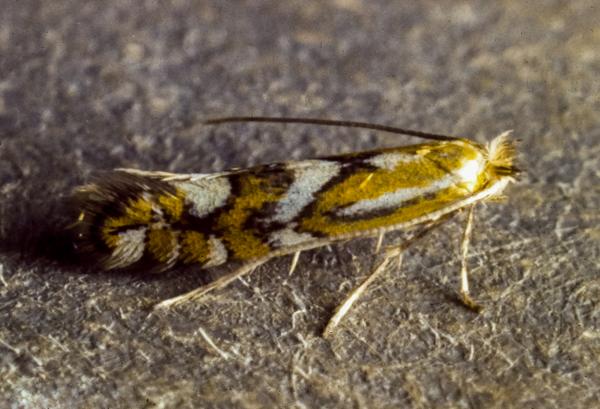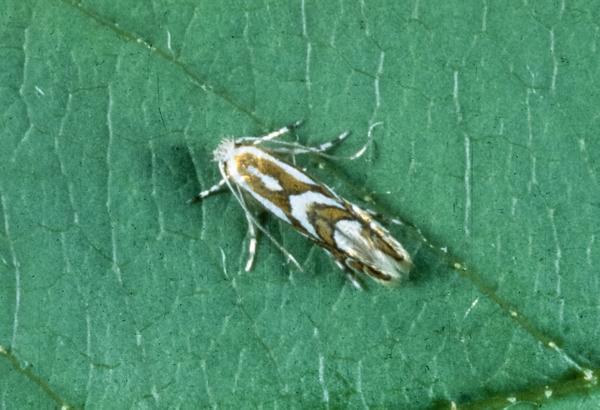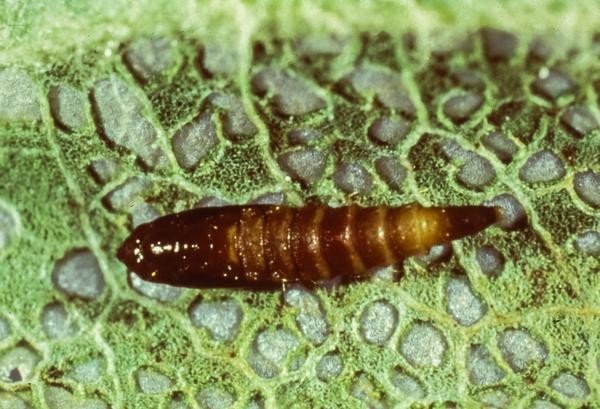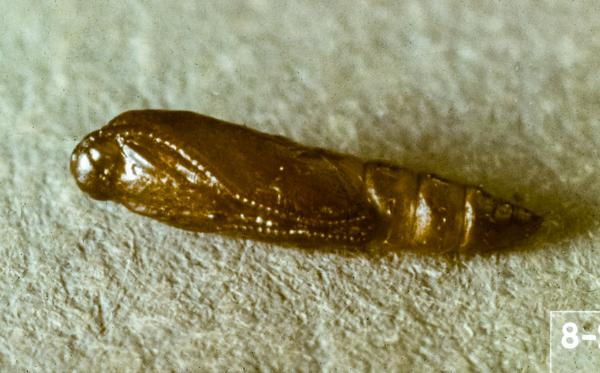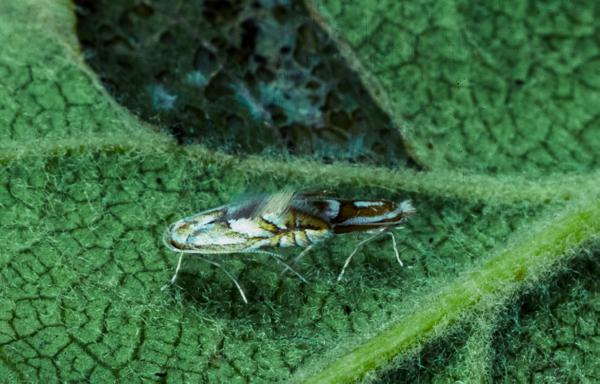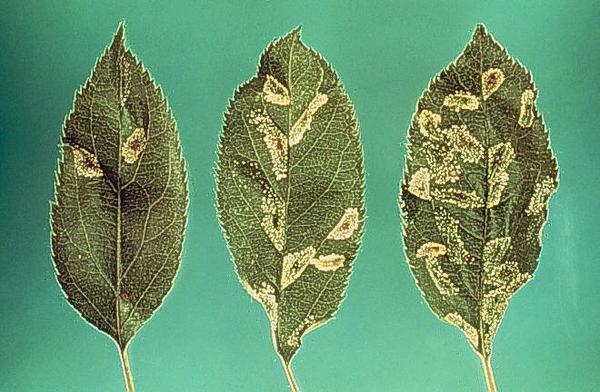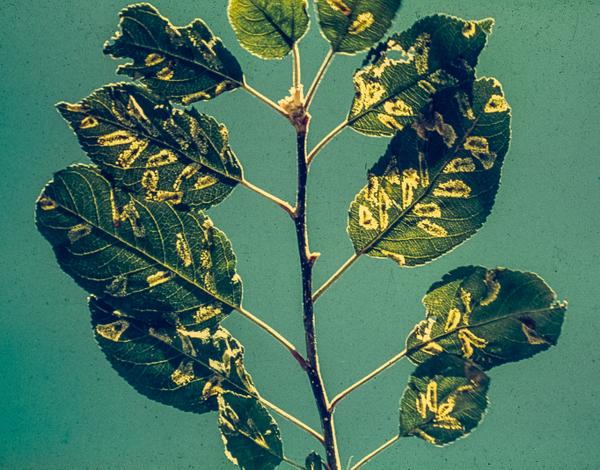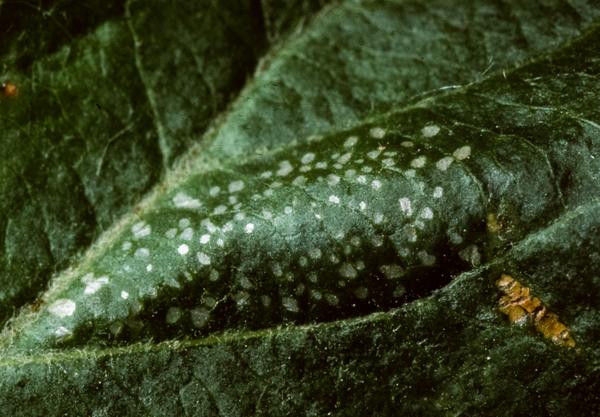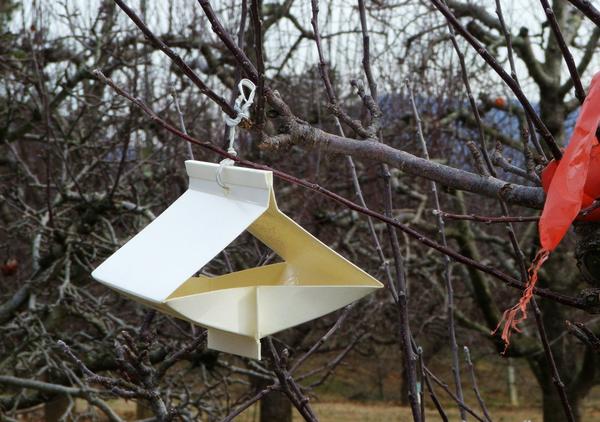Background and Description
Spotted tentiform leafminers (Phyllonorycter blancardella; STLM) are tiny moths originally native to Europe but now found throughout the eastern US and Canada.
Adult STLM are 1/8 inch (3mm) long and have brown wings with white transverse stripes outlined in black. Pupae are brown, tapered, and 1/8 inch (3mm) long. Larvae are yellow to pale green and grow to 1/8 inch (3mm) long after passing through 5 instars. Eggs are elliptical, cream-colored, and laid on the undersides of leaves. Roughly 1/10 inch (2.5mm) in diameter, they are not easily seen.
Life history
STLM pupae overwinter in fallen apple leaves. Adults begin to emerge around the half-inch green stage and continue through bloom. Females fly to leaves and lay about 25 single eggs which hatch in 6 to 10 days. Larvae go through two stages: "Sap-feeders" (1st-instar larvae) are very small and suck sap on one side of the leaf. "Tissue-feeders" (2nd- through 5th-instar larvae) are larger, have well-developed mouthparts, and feed on tissue inside leaves. A generation requires 35 to 55 days to complete, and there are usually 3 to 4 generations per year. STLM are usually active until leaves drop in the fall.
Damage
STLM feed inside leaves, creating "mines." A mature mine can reduce a leaf's green tissue by 5%, and the feeding site may buckle into a small tent. A very high population of leafminers is necessary before this damage becomes significant, but populations can increase rapidly if the STLM's natural enemies (parasitic wasps) are eliminated from the orchard. Mining can be especially damaging when combined with drought, mites, or foliar diseases.
Monitoring and Control
The presence of STLM adults can be monitored with pheromone traps, but a careful field search is necessary to estimate the size of a population. Use the methods and chart below to determine the need for action. Note: Mines remain visible after STLM larvae have emerged or been killed by sprays, so it is necessary to open them and check for larvae to determine if they are active.
First generation eggs: If an insecticide effective against STLM is not routinely applied at tight cluster to pink, sampling for first generation eggs may be useful to determine the need for control of first generation larvae (though first generation larvae rarely increase to damaging levels). Select 5 terminals per tree and use a hand lens to count the number of eggs on the underside of the second, third, and fourth leaves (in the order they unfold).
First generation larvae: Select 5 terminals per tree and count the number of mines on the underside of the second, third, and fourth leaves (in the order they unfold).
Second and third generation larvae: Select 5 mature leaves per tree from the periphery of the tree and count the total number of sap and tissue mines.
| Generation | Sampling Period | Action Threshold Level |
|---|---|---|
| 1st egg | Pink | 6 eggs / cluster |
| 1st larval | Petal fall - first cover | 1 mine / leaf |
| 2nd larval | 3rd and 4th cover | 2 mines / leaf |
| 3rd larval | July | 5 mines / leaf |
See the "Pest and Orchard Management Program" section of the Integrated Orchard Management Guide for Commercial Apples in the Southeast for the most current control guidelines.
Publication date: Feb. 23, 2015
N.C. Cooperative Extension prohibits discrimination and harassment regardless of age, color, disability, family and marital status, gender identity, national origin, political beliefs, race, religion, sex (including pregnancy), sexual orientation and veteran status.

